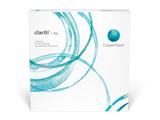
When cared for properly, contact lenses can provide an effective way to correct your vision. In fact, more than 45 million Americans wear contact lenses.2 Taking proper care of your contact lenses is essential. Conversely, failure to wear, clean, and store your lenses as directed by your eye care professional increases the chance of getting germs in your eyes and causing complications.3-5 The bottom line is this: Contact lens health starts with you. Your habits, supplies, and eye care professional visits are all essential to continued good eye health. The following healthy habits are recommended by the CDC to safely wear contact lenses and help protect your eyes:
- Don’t sleep in your contact lenses. Unless specifically prescribed by your eye care professional, don’t sleep in your contact lenses. Sleeping while wearing contact lenses has been shown to cause up to 8 times greater risk of an eye infection.6-7
- Wash and dry your hands. Always wash your hands with soap and water before handling your lenses. Then, before touching your contact lenses, dry your hands well with a clean cloth.
- Keep contact lenses away from all water. Water can introduce germs to the eyes through contact lenses. Remove contact lenses before swimming and avoid showering in them. Water can harbor microorganisms that can lead to severe infection. Do not store the lenses or rinse the lens case with water or any non-sterile solution
- Properly clean your lenses. Be sure to follow the instructions for use on your eye care professional’s recommended contact lens care solution. If you wear daily disposable or 1 Day contact lenses, cleaning with a solution is not required as they are not to be re-used.
- Take care of your contact lens case. Clean your contact lens case by rubbing and rinsing it with contact lens solution. Just as you should never use water on your lenses, never use water to clean the case. Next, empty and dry the case with a clean tissue. After each use, store the case upside down with the caps off. Importantly, you should replace your contact lens case at least once every three months.
- Talk with your eye care professional. Depending on your ocular, vision, and systemic health, your eye care professional will establish how frequently you need to be seen for eye exams. Always keep current on these eye appointments and, during your next visit, take the time to have a conversation with your eye care professional to discuss your contact lens wear and care habits. If you have any concerns between scheduled visits, promptly contact your eye care professional. Importantly, you should also remove your contact lenses immediately if you have eye pain, discomfort, redness, or blurred vision.
- Be prepared. You never know when you may need to take out your contact lenses. Be prepared by carrying a backup pair of glasses with a current prescription—just in case something unexpected occurs.
For a full list of General Lens Care, please refer to our Patient Information Booklets, which can be found at coopervision.com.
Stay Healthy All Year Round
You only have one pair of eyes, so take care of them! Your contact lens wear and care habits, supplies, and doctor visits all work together to keep your eyes healthy. Healthy habits equal healthy eyes. By following best practices, you can enjoy the comfort and benefits of contact lenses today and throughout the entire year.
References:
1. Jones L, Walsh K, Willcox M, Morgan P, Nichols J. The COVID-19 pandemic: Important considerations for contact lens practitioners. Contact Lens & Anterior Eye. 2020;43:196-203.
2. Cope JR, Collier SA, Nethercut H, Jones JM, Yates K, Yoder JS. Risk Behaviors for contact lens–related eye infections among adults and adolescents — United States, 2016. MMWR Morb Mortal Wkly Rep. 2017;66(32):841-5.
3. Bui TH, Cavanagh HD, Robertson DM. Patient compliance during contact lens wear: perceptions, awareness, and behavior. External Eye Contact Lens. 2010;36(6):334-9.
4. Dumbleton KA, Woods CA, Jones LW, Fonn D. The relationship between compliance with lens replacement and contact lens-related problems in silicone hydrogel wearers. External Contact Lens Anterior Eye. 2011;34(5):216-22.
5. Stapleton F, Edwards K, Keay L, Naduvilath T, Dart JK, Brian G, Holden B. Risk factors for moderate and severe microbial keratitis in daily wear contact lens users. External Ophthalmology. 2012;119(8):1516-21.
6. https://www.cdc.gov/contactlenses/protect-your-eyes.html
7. https://www.cdc.gov/contactlenses/pdf/Contact-Lens-Health-Week-2020-Toolkit-p.pdf





